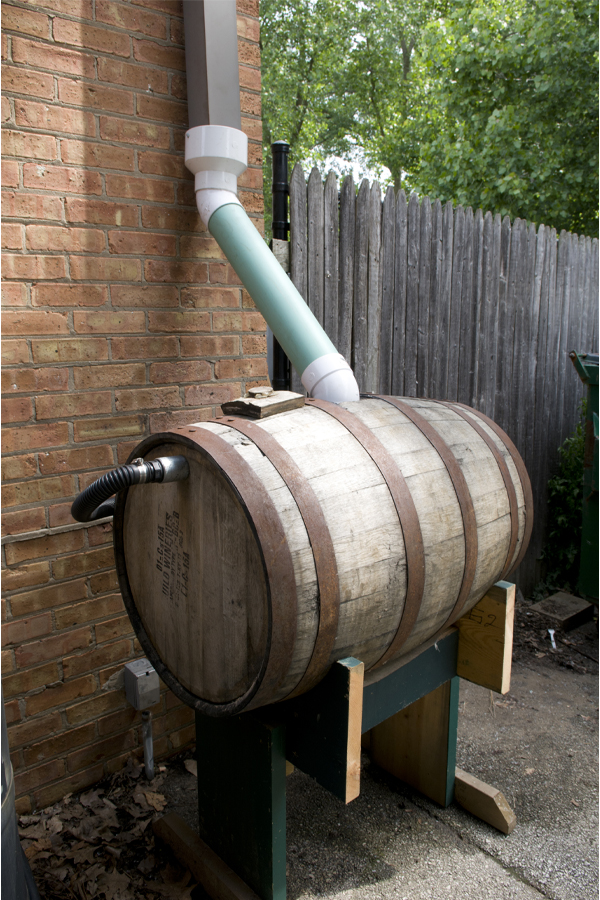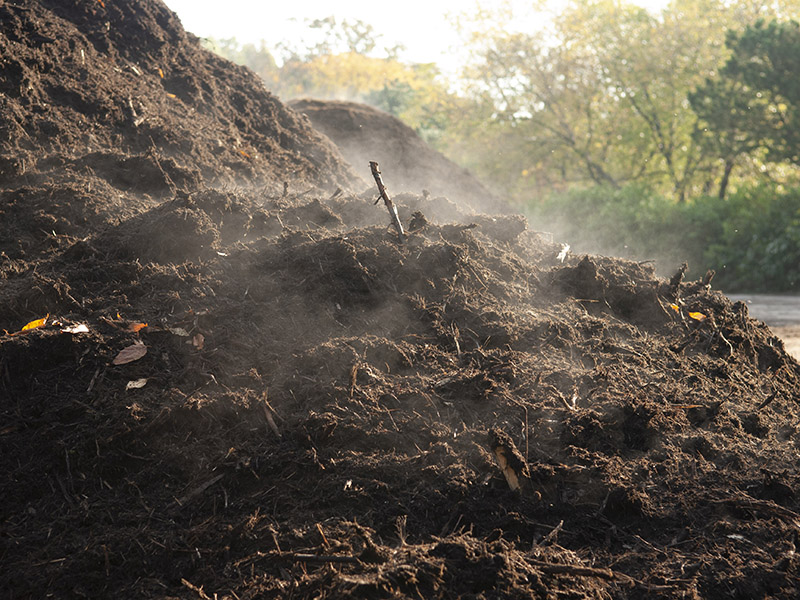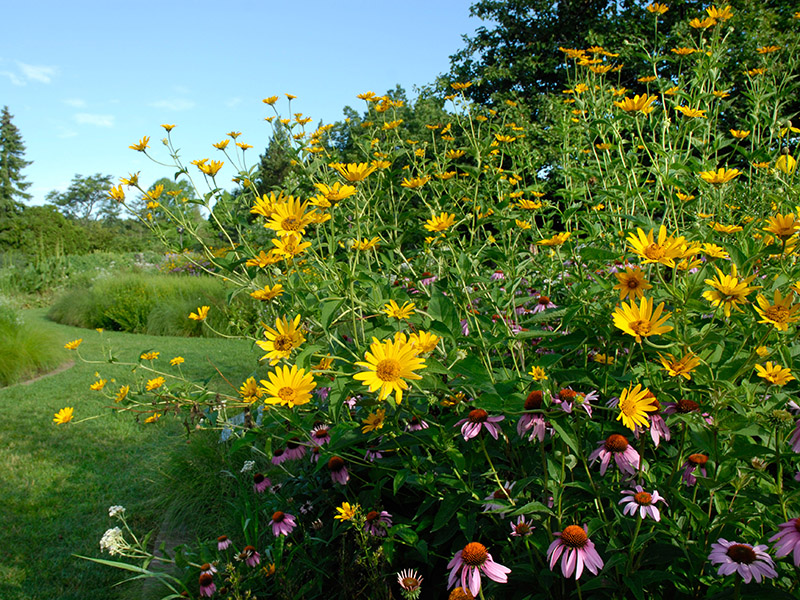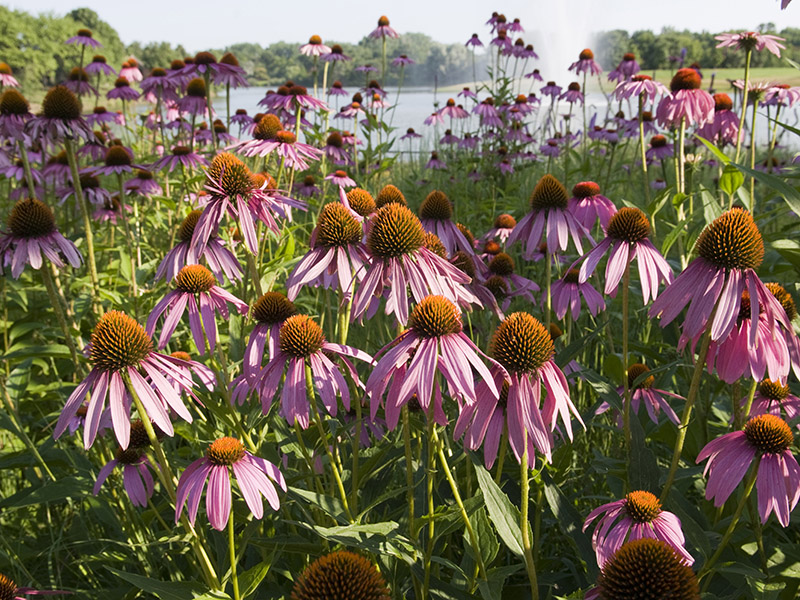

Tips & Techniques
A Green Gardening Primer
More and more people are talking about ways to green their gardening. We hope you find this information useful for your own gardening purposes.
Biodegradable
Biodegradable products or packages decompose into elements found in nature within a reasonably short period of time after normal disposal or use, reducing the volume of materials stored in landfills and offer recyclable alternatives. In gardening, biodegradable seed-starting pots, nursery pots, and containers are available.
Bioswale
A bioswale is a shallow channel that has been created in the landscape to temporarily store rainfall draining from hard surfaces like rooftops, parking lots, and roads. Bioswales reduce the amount of rainfall diverted to storm sewers by allowing some of the water to percolate into the soil and replenish local groundwater aquifers. Usually lined by grass or specially selected plants, bioswales improve water quality by filtering out waterborne pollutants. More and more often, you can find bioswale channels running through paved parking lots or between expressway lanes. In some communities, commercial building codes require bioswales to reduce the need for larger sewer systems.
Carbon Footprint
Carbon dioxide is one of a handful of common greenhouse gases associated with global climate change. A carbon footprint is a measure of greenhouse gas emissions that a person, business, or even municipality is adding directly or indirectly to the environment. Lifestyle changes that reduce carbon emissions help to mitigate the negative impact of global climate change. Driving fewer miles in gas-powered vehicles and using less coal-generated electricity are common approaches to reducing one's carbon footprint.
Garden-related practices and products that increase the size of a carbon footprint include using gas-powered garden equipment, using municipal water for irrigation, and the production of synthetic fertilizers. Planting trees and long-lived shrubs helps to mitigate the effects of climate change because these plants remove and store carbon that is already in the atmosphere.
Compost
Compost is the end-product of composting; a process in which organic matter is collected, mixed, and allowed to decompose. Compost can be used to amend soil, or as a mulch layer on garden beds and around trees. In nature, deciduous leaves create a mulch layer that eventually decomposes. Like human-made compost, this natural recycling process returns nutrients to the soil and improves soil structure, and it is one reason native plants growing in natural ecosystems usually do not need more fertilizer than nature provides. Composting is a favorite technique for homeowners looking for easy ways to green their gardening practices. In addition to reducing the need for expensive fertilizer—and the adverse effect fertilizer runoff can have on our lakes and streams—composting reduces the amount of garden debris that ends up in landfills.
Ecosystem
An ecosystem is the complex set of natural relationships between the landscape and the organisms that live there. An ecosystem includes the plants, insects, birds, soil, waterways, fish, and people living together. Individual ecosystems are interconnected, and changes in one can have a serious effect on others. Healthy ecosystems are in balance and able to perpetuate themselves. Concerns about climate change include the effects that changing temperatures and precipitation amounts are having on ecosystems, and the ability of native plant and animal communities to survive. Scientists worldwide are creating banks where seeds can be stored and used, if needed, to prevent plant extinction or restore biodiversity.
Green Roof
A green or “living” roof uses specialized roofing material, a soil substitute, and drought-tolerant plants to help building owners and homeowners save energy, better manage stormwater, and mitigate the urban heat island effect. Green roofs absorb and store stormwater; a key component in a stormwater management system that often includes the use of bioswales and native plants. A green roof slows stormwater discharge from building eaves and gutters, reducing the immediate demand placed on sewer systems during large storms, which helps to decrease the likelihood of flooded basements. Green roofs also help to insulate buildings—keeping them cooler in summer and warmer in winter, and leading to lower energy bills and reduced carbon emissions related to energy production.
Native Communities
A native community is the population of native plants, animals, and soil microbes in a specific ecosystem. Each community has evolved together over hundreds of thousands of years and the members depend on each other for shelter, food, and survival. Nonnative and invasive animals, plants, and insects have shown how they adversely affect native communities and disrupt entire ecosystems.
Native Plants
Native plants are the trees, shrubs, perennials, and annuals that were growing in an ecosystem before nonnative settlers and plant explorers introduced new plants. Native plants have adapted to native soils, soil organisms, and weather, and provide important habitat and food for native animals and insects. They usually need little supplemental water and often have fewer serious disease or insect problems, with the result often being that it takes less time, money, and garden chemicals to keep native plants healthy. Plants can be native to cities, regions, or continents. Most nonnative plants are not invasive, but those that are can have a serious negative effect on the health of ecosystems and native communities.
Organic
The primary goal of organic agriculture is to optimize the health and productivity of natural communities. Adhering to organic practices promotes the health and productivity of the soil's microbial community, plants, animals, and ultimately people. For home gardening, organic principles are best put into practice by doing the following:
- Improving soil health
- Choosing appropriate plants
- Using soil amendments and fertilizers when necessary, and then using only those made from naturally occurring (nonsynthetic) substances
- Employing cultural, biological, and/or mechanical practices to address challenges posed by pests and pathogens
- Composting disease-free plant material for later use as a soil amendment or mulch
Rain Gardens
Similar to bioswales, rain gardens are an ornamental feature for home landscapes that help manage rainfall and solve problems caused by slopes and low spots. Rain gardens capture and collect rainfall so it can be absorbed into the soils slowly over time. They also remove silt, filter contaminants, and replenish groundwater aquifers. Rain gardens use plants that can tolerate periods of both extreme moisture and drought.
Sustainable
Sustainable practices are those that meet the needs of today without compromising the needs of the future. Sustainability can apply to every aspect of our lives—what we eat, how we shop, where we live, how we travel, and even how we garden. In gardening, sustainable practices conserve energy and water and reduce waste. This includes selecting long-lived plants that are right for the conditions you have for planting—the amount of sun or shade, type of soil, winter hardiness, and ability to thrive in the natural variations in rainfall. Sustainable gardening practices also include growing plants or crops that don't need frequent irrigation or chemical controls to keep them healthy and using light carbon-footprint techniques such as mowing turfgrass with an electric mower.







